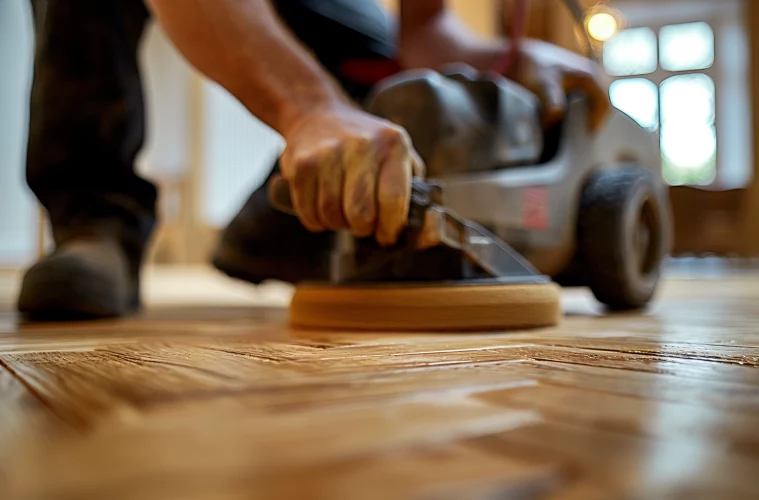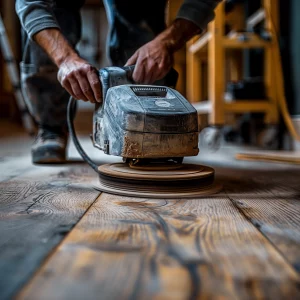Choosing the right floor sanding method for your home in Brighton involves weighing the advantages and disadvantages of manual versus machine sanding. Each technique offers unique benefits and challenges, depending on the type of floor, the desired outcome, and the environmental considerations.
In this detailed exploration, we aim to provide homeowners, property owners, and rental property owners in Brighton with comprehensive insights to make informed decisions about floor sanding.
Technique Introduction
Hand Sanding:
This traditional method is renowned for its artisanal approach, offering meticulous attention to detail and unparalleled control over the sanding process. Hand sanding allows for a personalised touch, catering to the unique contours and intricacies of each floor. The result is a floor with character and a testament to skilled craftsmanship.
Machine Sanding:
In contrast, machine sanding is celebrated for its efficiency and ability to achieve uniform coverage across large areas quickly. This method leverages advanced technology and mechanical force to streamline the sanding process, reducing labour time and potentially lowering costs for larger projects.
Operational Dynamics
The decision to use manual labour or mechanical force for floor sanding necessitates a deep dive into the specific demands and goals of each project. Opting for manual sanding means committing to a process that demands a high level of tactile knowledge and a meticulous, hands-on technique. This approach shines in tasks requiring fine precision and attention to detail, making it indispensable for work that demands a personal touch and craftsmanship.
Conversely, machine sanding is the go-to for those valuing rapid completion and uniform results, as it leans heavily on technical proficiency in equipment handling. This method emphasises achieving a balance between speed and quality, making it ideal for larger areas where efficiency and consistency are paramount.
The choice between these approaches hinges on a strategic evaluation of the project’s scale, desired finish, and the specific nuances of the floor’s material and design.
Surface Interaction
The interaction between the sanding method and the floor surface is critical in achieving the desired outcome. Hand sanding, with its adaptable and gentle approach, excels in preserving the unique characteristics and intrinsic beauty of the floor. This method is particularly suited for working with irregular contours and delicate edges, allowing for a nuanced restoration that honours the original craftsmanship.
Machine sanding, in contrast, employs a more forceful technique designed to efficiently tackle large, flat areas. Its strength lies in creating a smooth and level surface, but this comes at the cost of potentially overlooking the fine details that contribute to a floor’s unique charm.
The choice between these methods should thus be informed by a thorough assessment of the floor’s current condition and the aesthetic goals of the renovation, ensuring that the chosen technique aligns with the vision for the space.
Outcome and Aesthetics
The aesthetic impact of the chosen floor sanding method is profound, influencing the ambience and character of your home. Hand sanding is akin to an artisan’s touch, capable of unveiling and enhancing the innate beauty and intricacies of the wood grain, leading to a finish that’s as unique as the floor itself. This method allows for a level of customisation and detail that celebrates the material’s natural variations and the artisan’s skill.
On the flip side, machine sanding offers a more homogeneous finish characterised by consistency in texture and colouration across the surface. This can be advantageous for achieving a modern, sleek look that emphasises uniformity and simplicity.
Ultimately, the decision hinges on the homeowner’s aesthetic vision and how they wish the floor to contribute to the overall design narrative of their space.
Practical Considerations
The choice between hand and machine sanding involves weighing key practical factors, including the project’s timeframe, labour intensity, and financial implications. Hand sanding demands a considerable amount of skill and patience, making it a labour-intensive option that could lead to increased costs, especially for projects necessitating intricate detail and precision.
In contrast, machine sanding requires upfront investment in machinery but offers significant efficiencies for large-scale projects. This method can dramatically reduce the time and labour needed, potentially lowering overall costs in the long run. Balancing these considerations is essential for selecting the most appropriate and cost-effective sanding method for your project.
Area Suitability and Application
The decision between hand and machine sanding hinges on the unique demands of the project area. Hand sanding excels in small, detailed spaces where its precision can meticulously address complex contours and fine details, preserving the integrity and aesthetic of the surface. It’s the method of choice for projects that require a delicate touch.
Conversely, machine sanding stands out in large, open areas, where its efficiency and ability to quickly cover ground make it invaluable. This method ensures uniformity and consistency over extensive surfaces, optimising time and labour.
Tailoring the sanding approach to the specific characteristics and requirements of each space is crucial for achieving the desired outcome and fulfilling the project’s broad objectives.
Health and Safety
Health and safety are critical elements in the floor sanding process, directly impacting the well-being of those involved. Machine sanding, with its automated nature, minimises physical strain and reduces the risk of fatigue-related injuries, making it a preferable option for projects that demand extensive labour. Despite this advantage, it’s essential to recognise that both manual and machine sanding pose risks to hearing due to noise generation and respiratory health from dust production.
Effective dust management systems and the use of personal protective equipment, such as hearing protection, are indispensable regardless of the method chosen. These measures ensure a safer work environment, protecting operators from potential health hazards and promoting more comfortable and sustainable working conditions.
“Effective dust management is the cornerstone of a healthy and efficient floor sanding process. It not only safeguards the health of everyone involved by minimising airborne particles but also ensures a cleaner work environment, leading to superior finishing results. Utilising advanced dust extraction systems and adhering to best practices in dust control are non-negotiable elements of our profession, enabling us to deliver top-quality work while maintaining a safe workspace.” – Jim Goodall, GJP Floor Sanding.
Environmental and Economic Sense
Manual sanding is lauded for its eco-friendliness, primarily because it consumes significantly less energy compared to its mechanical counterpart. This method aligns with sustainable practices, minimising the environmental footprint of floor renovation projects.
On the flip side, machine sanding, despite its higher initial energy use and investment, brings substantial productivity gains. It enables quicker completion of large-scale projects, reducing labour costs and potentially lessening the overall environmental impact through efficient use of resources. Over time, these benefits can offset the initial outlay, presenting a compelling case for machine sanding from both an economic and a sustainability standpoint.
Preparation and Completion
Achieving exceptional results in floor sanding hinges on meticulous preparation and thorough completion, regardless of whether hand or machine sanding is employed. The process begins with a detailed assessment to tailor the approach to the floor’s specific condition, followed by careful preparation to set the stage for effective sanding.
After sanding, the application of final touches, such as buffing, not only elevates the floor’s aesthetic appeal by enhancing its shine but also serves as a critical step in preserving its beauty over time. Additionally, providing comprehensive maintenance advice ensures that the floor remains in pristine condition, securing its allure and longevity.
Final Thoughts
Whether opting for the artisanal precision of hand sanding or the efficient uniformity of machine sanding, the choice fundamentally depends on the specific requirements and goals of your Brighton home’s flooring project.
Each method offers distinct advantages, from the personalised touch and detail of manual work to the speed and consistency of mechanical processes. By carefully considering the operational dynamics, practical implications, and the desired aesthetic outcome, homeowners can make an informed decision that best suits their needs, ensuring a beautifully finished floor that stands the test of time.







